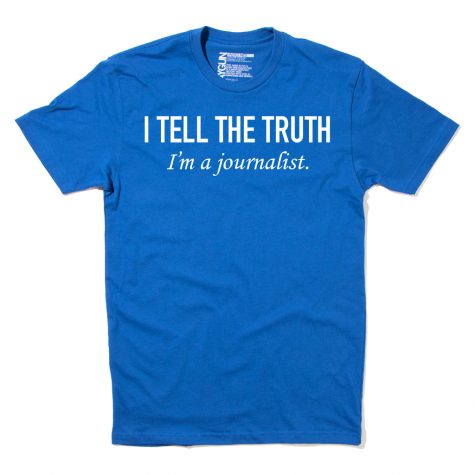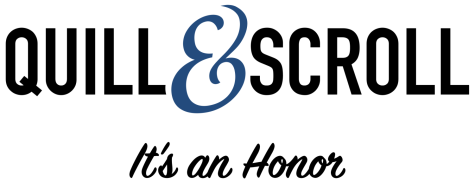The Weekly Scroll
September 30, 2019
News, tips and advice from Quill and Scroll
The Lede
Talk of Trump’s impeachment from Pelosi and other congressional Democrats.
President Donald Trump is in hot water after his alleged attempt “to extort Ukraine’s new government into investigating Joe Biden” was made public from a whistleblower. The news of that alleged manipulation prompted a formal impeachment inquiry of Trump by Speaker Nanci Pelosi on Tuesday, jumpstarting an endless continuum of coverage by Washington D.C. reporters who are working to keep the public informed.
SCOTUS precedent states it is the duty of Congress to investigate the chief officer of the executive government should they improperly exceed or abuse the powers of the office, behave incompatibly with the function and purpose of the office, or misuse the office for an improper purpose or for personal gain:
It is the proper duty of a representative body to look diligently into every affair of government and to talk much about what it sees. It is meant to be the eyes and the voice, and to embody the wisdom and will of its constituents. Unless Congress have and use every means of acquainting itself with the acts and the disposition of the administrative agents of the government, the country must be helpless to learn how it is being served; and unless Congress both scrutinize these things and sift them by every form of discussion, the country must remain in embarrassing, crippling ignorance of the very affairs which it is most important that it should understand and direct. The informing function of Congress should be preferred even to its legislative function.
In that respect, congressional members act much like journalists in their responsibility to shine a light in the dark corners of government that jeopardize its service to the public, to be the watchdog of those in power and bark when corruption is found. This is an important moment for journalists and congressional members to unite in the similar purpose of uncovering the truth and keeping the public informed, for it is ta responsibility of both to endeavor in since they have a loyalty to the public and the integrity of good work.
Controversy outside of Trump’s alleged misuse of the office includes The New York Times revelation of the whistleblower’s employee credentials. That unveiling by the Times potentially makes it easier for officials and the Trump office to identify the whistleblower and endanger him. Backlash was immediate after the Times posted this story about the whistleblower, Twitter using taking it upon themselves to trend #CancelNYT. It puts into conversation the question about what news and media organizations should or should not publish, what the boundaries are, and where ethics lies in the publishing industry.
Amid the controversy, The New York Times published this helpful timeline of events covering Trump’s efforts to push Ukraine toward investigating political rival Joe Biden.
While the story about Trump’s meddling went viral Sept. 20 with The Wall Street Journal, original reporting of the story was published in this editorial from The Washington Post. Take a look at the post below to see the original reports on the topic and how it set afire the impeachment inquiry of the president.
Our Washpost editorial looks at what could be our next election scandal: Trump’s attempt to extort Ukraine’s new government into investigating Joe Biden. https://t.co/b4Yw3vmjCD
— Jackson Diehl (@JacksonDiehl) September 6, 2019
Also, read this piece on the impeachment story in the age of the internet:
The last time America watched an impeachment inquiry, it was largely an analog affair. When the House voted to begin impeachment proceedings against Bill Clinton in 1998, only one in four American homes had internet access. AOL and Yahoo were the biggest websites in the world, and “tweet” was a sound birds made.
Vox Media and New York magazine merge
The New York Times broke the news that Vox Media was acquiring New York magazine on Sept. 24, eliciting a slew of different reactions. On the one hand, big mergers like this have sent fear through employees and reporters alike, wondering where they stand int his merger since both companies have quite a bit of content overlap. CNN covered that angle of worried staffers, presenting an inside look at the prevalent and growing concern for job security in the journalism industry.
On the other hand, Nieman Lab Director Joshua Benton presented a well-thought out analysis of the marriage, suggesting the “substantial audience overlap, similar editorial values, strong reputations for quality” are a recipe for success in this day and age of journalism in the digital world.
Some takeaways from Benton on the marriage:
- The merger is a potentially rare one, where scale of the publication can soar while not jeopardizing culture in a nasty clash.
- The approach from the two companies overlaps, but in complementary ways that apparently won’t accompany editorial layoffs (hot!)
- Both generate revenue from events and this fusion should work well between the two in establishing some e-commerce.
A good quote from Benton that elicits a fondness for both companies: “I like this deal. I like both companies involved and how they fit together. I like that there’s a legitimate growth story to be told, not just a cut-until-you-hit-profit one — which is the narrative most American newspapers are facing, unfortunately. I’m sure roadblocks will pop up along the way, at all levels of the new operation. But I think these two have a real shot at making it work — maybe even growing old together. And the kids will probably be cute.”
Looks like a photo for a Vows column. https://t.co/ehuoupcjdh
— katie rosman (@katierosman) September 25, 2019
It’s An Honor
 “I TELL THE TRUTH” t-shirts available for your staff
“I TELL THE TRUTH” t-shirts available for your staff
Now is the time to order your Quill and Scroll “I TELL THE TRUTH — I’m a journalist” t-shirts. As you know, “Truth” is the first pillar upon which Quill and Scroll was founded in 1926.
We’re taking pre-orders from now through Sept. 15, 2019, and we’ll deliver your shirts by Oct. 15, 2019 or earlier. Every time we get to 100 t-shirts ordered, we’ll print up a new batch and ship them to you.
All profits will go to the Quill and Scroll Scholarship Fund, which benefits Quill and Scroll members who plan to study journalism in college.
Just fill out the form at this link to tell us how many you want in each size. We’re offering a unisex style and a female-fit style. RAYGUN is printing the shirts for us, and you can read about their “USA-made” t-shirts here.
Of course, we’d like every Quill and Scroll member to wear one, but these shirts are good for any journalist.
We will accept only credit card payments, and there’s a per-order charge for that, so order all your t-shirts at one time and save!
Yearbook Excellence Contest deadline approaching!
The 2019 Yearbook Excellence Contest is underway and Quill and Scroll will accept entries until Thursday, Oct. 10. Just go to this page, and you’ll see rules, guidelines and forms for entry. Entries cost $5 for individual entries and $10 for a school’s theme development entry. Don’t wait for the last minute, get this done now to see how your work stacks up against those of your peers from schools across the U.S. and Canada.
Quill and Scroll on the road

Photo by Luke Stackpoole on Unsplash
Quill and Scroll Executive Director Jeff Browne will again be touring nearby states this fall for their various journalism conferences. He just finished a little trip to Fort Collins, Colorado for Journalism Day at CSU, which remains one of — if not the best attended workshop in the U.S. More than 1,400 students from about 100 schools attended.
What’s next on this year’s itinerary:
- Oct. 21 in Lincoln, Nebraska for the NHSPA fall convention
- Oct. 24 in Iowa City, Iowa for the IHSJA fall conference
- Nov. 21-23 in Washington, D.C. for the National High School Journalism Convention
Let us know when your state is hosting its conference because we’d love to have a presence there. And if you see Jeff, stop by his table to say “hello.”
What’s Viral?
Queer Eye’s Jonathan Van Ness opens up discussion about HIV, sexual abuse and drug addiction
If you’re a fan of “Queer Eye” on Netflix (and just about everybody here at Q&S loves the Favb Five), then you’ve probably also fallen in love with its gender-bending aesthetician, Jonathan Van Ness. But you probably don’t know Jonathan’s whole story. Click on JVN’s photo below to read his tale.
Guess who’s back, back again? Rightful AP hyphen usage is back—tell a friend.
Yeah, that “getting-rid-of-the-hyphen” thing that AP tried to foist on pedants and copy editors across the country? Not so much.
AP last week pulled back on its insistence that there really aren’t such things as hyphen rules. There are. Deal with it. Click on the photo to read the whole story.
Hidden stories are finding a place in New York
“VOICES OF NEW YORK began on September 11, 2001, as an effort to combat Islamophobia in the aftermath of the World Trade Center attacks, and focused at first on the city’s Muslim communities. In 2011, the Craig Newmark Graduate School of Journalism’s Center for Community and Ethnic Media (CCEM) took the project over and broadened the mission to encompass all of New York City’s ethnic and community outlets.”
That’s from a story in the Columbia Journalism Review. You can read how journalistic outlets around the city and the world have endeavored to tell those story over the past 18 years. It’s a fascinating glimpse into America’s most-populous urban area.
And it’s a challenge to high school journalists to see if they can do the same sort of work as a regular, sustained project over time, not just a single month, semester or year.
Just a Thought
Transparency vs. Relevance: why investigating social media may be going too far
A short opinion piece by Sylvia Clubb of Q&S
ISU Fan Turns Beer Money Sign into Viral Fundraiser for Children’s Hospital #CyHawk #collegegamedayhttps://t.co/wDzeUezRx6 pic.twitter.com/7I4ETbw2dH
— Justin Surrency (@JustinSurrency) September 17, 2019
Carson King, a student at Iowa State University, recently rose to fame after pledging to give all donations made to his Venmo account to the University of Iowa Stead Family Children’s Hospital – known for “the wave.” The pledge was made after King received national attention for a sign made and featured on ESPN’s College GameDay Sept. 14.
After hitting the $1 million donation mark with the help from Anheuser Busch and Venmo, a feature was to be written on King in The Des Moines Register, a local newspaper. The decision was made to look into King’s social media history. Upon inspection, it was found that King released a racist tweet at age sixteen (eight years prior to the event at hand) quoting the popular show Tosh.0. King himself released an apology statement for the tweet, calling it, “an attempt at humor that was offensive and hurtful.” King’s statements made at age 16 caused him to lose part of his partnership with Anheuser Busch, which would have resulted in King receiving a year’s supply worth of custom-made Busch Light’s.
Supporters of King everywhere were in uproar after this event. Videos were posted to social media featuring King supporters throwing away any Busch products in their possession and threatening The Des Moines Register to the point police presence was requested. How could a mistake King made, completely unrelated to the fundraising process or event at hand, come back to affect him eight years later?
This event poses an ethical dilemma to journalists everywhere: how are we to be transparent to the public, yet remain relevant to the story at hand?
King’s tweet had nothing to do with sick kids. Was it wrong: yes. Did the exposure of that tweet have the possibility of harming the fundraising campaign: yes. Luckily, nothing but ample support has been provided to King since the statement was released to the public. However, the situation could have been drastically different.
As journalists, it is our job to provide all of the facts to the public — good or bad. Those lines get blurred when it comes to good people making bad decisions. But part of our job as journalists is to determine what is most pertinent to our story. How do we decide what is more important to the public: transparency or relevance?
In King’s case, he apologized for the statements he made as a 16-year-old kid before the information was released by the reporter. His actions over the past eight years do not reflect the tweet he made with his friends at 16; he’s raised more than $1.5 million dollars for a rivalry school’s children’s hospital. He continues to take full responsibility for his actions and is still receiving donations for the children’s hospital in his name. The reporter who originally found the tweets, however, was fired due to the presence of racist comments on his own personal Twitter. The investigation came full circle and ended up biting the reporter worse than King.
If King’s Twitter would never have been investigated, King would still receive his year supply of Busch Light, and the reporter (most likely) would not have been fired.
So, I will leave you with this my fellow journalists: where is the line drawn? Is it based off age of comments, age of the propagator, the situation? Or is it simply about making a mistake, once in your life?
